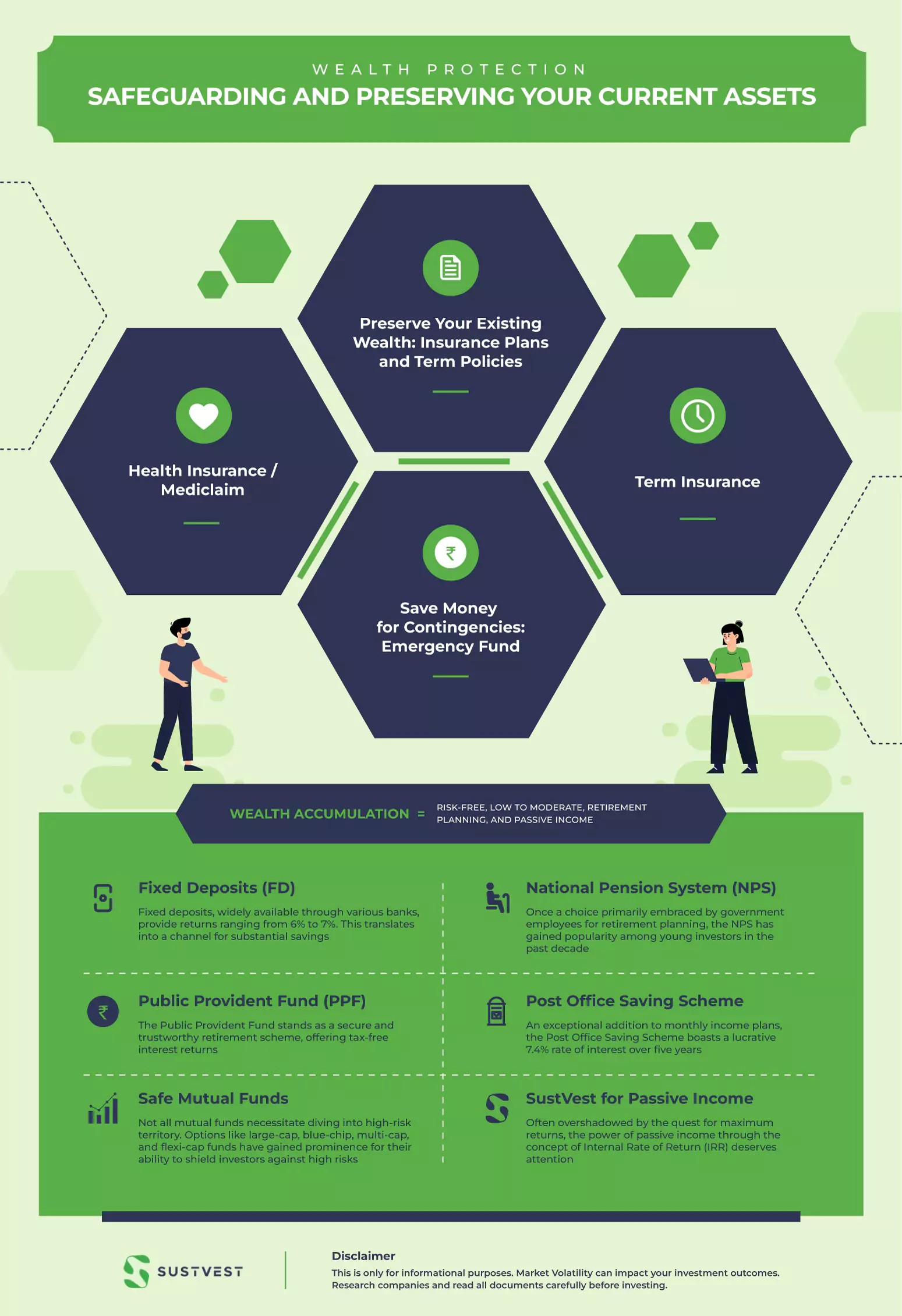If you’re a business owner, chances are you’ve already devised a business plan with one primary aim – to recover your initial capital and then foster substantial growth in your business investment. Whether you’ve mapped out a 5-year strategy, the essence remains quite unchanged, right?
In a similar way, consider the concept of putting your money to work through the prism of the financial planning pyramid.
The foundational, involves earmarking funds for unforeseen events, often achieved through insurance. Finally, once you’ve established a solid financial footing with a safety net, you venture into investment pyramid with moderate to high risks.
Let’s distill these blocks of financial pyramid into 3 concise stages:
- Wealth Protection: Safeguarding and accumulating funds.
- Wealth Accumulation: Investing in avenues with lower risk.
- Wealth Distribution: Exploring higher-risk investments and laying the groundwork for succession plans.
This approach tailors your financial strategy, ensuring secure and well-prepared future by safeguarding your resources.
Read more about financial planning

3 Steps Of Financial Pyramid
Wealth Protection: Safeguarding and Preserving Your Current Assets
This phase of your planning financial pyramid determines how well you can keep your existing wealth. We often encounter individuals who were once financially well-off, only to have their fortunes wiped out by a single crisis. If you’re eager to avert such a scenario, this step is pivotal.
Preserve Your Existing Wealth: Insurance Plans and Term Policies
Insuring all your valuable possessions prone to damage and incurring substantial costs is an investment worth paying premiums for. Whether it’s your vehicle or, if you’re a business owner, coverage for your shop, having comprehensive insurance is crucial. As a general rule, maintaining insurance coverage at around ten times your current income is advisable. However, consider investing in a minimum of two types of insurance products.
Health Insurance / Mediclaim
This coverage takes care of your medical expenses ranging from minor procedures like wisdom tooth extraction and cataract surgery to more significant orthopedic surgeries resulting from accidents not caused by your actions. Opting to pay a portion of these expenses through premiums is wiser than letting substantial sums drain away during a few days of recovery in a deluxe hospital room.
Term Insurance
Ensuring that your children and spouse are not left in financial turmoil if you’re no longer around is the essence of term insurance. It involves making financial provisions for your dependents, whether they’re your children, spouse, parents, or others, in your absence. It’s vital to have coverage that extends to critical illnesses and offers protection against accidental death and disabilities.
Save Money for Contingencies: Emergency Fund
Incorporating an emergency fund that covers six months of living expenses is essential for unforeseen circumstances such as prolonged illnesses, job losses, or employment gaps. This proactive step, aligned with the financial planning pyramid prevents you from tapping into your investments or savings during times of need. Establishing a dedicated fund for situations where your earning capacity is compromised can sustain your daily needs–including basic lifestyle expenses and sustenance–for at least six months.
Wealth Accumulation = Risk-Free, Low to Moderate, Retirement Planning, and Passive Income
Moving up the financial planning pyramid, once you’ve ensured enough insurance and emergency funds, it’s time to focus on wealth accumulation. This involves diversifying your income into safe to moderate return avenues. These avenues can help build a significant retirement fund and achieve mid-term goals like funding your children’s education or buying a house.
Fixed Deposits (FD)
Fixed deposits, widely available through various banks, provide returns ranging from 6% to 7%. This translates into a channel for substantial savings.
National Pension System (NPS)
Once a choice primarily embraced by government employees for retirement planning, the NPS has gained popularity among young investors in the past decade. With the flexibility to opt for aggressive risk allocation of up to 10%, even a modest monthly investment of ₹5000, when initiated before turning 30, can accumulate a corpus of ₹1.14 crore, considering conservative returns.
Adding allure to this option is the cherry on top – a tax-free 60% lump sum and 40% annuity distribution, rendering it an enticing investment avenue.
Public Provident Fund (PPF)
The Public Provident Fund stands as a secure and trustworthy retirement scheme, offering tax-free interest returns. Catering particularly to self-employed individuals, it allows yearly contributions ranging from as low as ₹500 per month to a maximum of ₹1,50,000. Notably, contributions up to ₹1,50,000 also qualify for a tax deduction, and the accrued returns remain entirely tax-free.
Post Office Saving Scheme
An exceptional addition to monthly income plans, the Post Office Saving Scheme boasts a lucrative 7.4% rate of interest over five years. With a cap for individual investment set at ₹9 lakh annually and a joint investment limit of ₹15 lakh, it stands as a government-backed, secure investment avenue.
Safe Mutual Funds
Not all mutual funds necessitate diving into high-risk territory. Options like large-cap, blue-chip, multi-cap, and flexi-cap funds have gained prominence for their ability to shield investors against high risks. Over the past five years, flexi-cap funds have yielded returns of 14%. Meanwhile, major multi-cap and large-cap mutual funds have consistently delivered returns ranging from 10% to 12%.
SustVest for Passive Income
Often overshadowed by the quest for maximum returns, the power of passive income through the concept of Internal Rate of Return (IRR) deserves attention. A concept that proves its superiority over the Compound Annual Growth Rate (CAGR).
Amidst this landscape, SustVest emerges with a distinctive advantage. Beyond the enticing 15% IRR, it not only offers financial returns but also contributes to the environment through rooftop solar energy. This approach ensures both monthly interest returns and a portion of your principal, a dual strategy to counter the effects of inflation.
By harmonizing these instruments in a well-proportioned manner, you lay the upper tiers of the financial planning pyramid over the strong foundation of insurance and emergency funds. Together, steps one and two ensure your future needs are well-prepared for.

Wealth Distribution: Allocating Funds for Long-Term Recovery
In this phase of the financial planning pyramid, the focus shifts to property development and succession planning. Whether it involves investing in real estate, high-risk mutual funds, currency, or commodities, the central goal is shielding your savings from potential losses. This is precisely why, once the initial two steps are complete, the third step takes center stage.
With a substantial portion of your Step two savings in hand, it’s time to contemplate investments in high-risk, high-return avenues.
Given the stable passive income flowing in from your Step two investments, you might feel confident exploring significant assets such as real estate or valuable artifacts, items you can preserve and pass down through the generations.
By following this approach, you’re not only securing your financial future but also creating a lasting legacy, staying true to the essence of the financial planning pyramid.
Discover Green Passive Income with SustVest
If you’re seeking an exceptional source of passive income, SustVest is the answer. This renewable investment opportunity could provide the returns you’ve been longing for, allowing you to earn a monthly income equivalent to a remarkable 15% IRR on your investment. By participating in ongoing or upcoming rooftop solar projects, you’re only scratching the surface of its potential.
A 15% IRR translates to receiving both principal and interest every month. Beyond the financial rewards, this also offers the gratification of contributing to environmental preservation while enjoying an impressive monthly passive income. SustVest: Where your search for green passive income finds its destination.
FAQs: Financial Planning Pyramid Explained in 3 easy Stages
1. What are the Levels of Financial Planning Pyramid?
- Protection: Establishing financial security through emergency funds and insurance.
- Savings: Building a foundation with systematic savings.
- Wealth Building: Growing wealth through investments and strategic asset allocation.
- Speculation: Exploring riskier investment options for potential higher returns, but with increased risk.
2. Do I Build a 6-month or 12-month Emergency Fund, Which is Recommended?
An emergency fund of 3 to 6 months’ expenses is often recommended, offering security against unforeseen events. Depending on your risk tolerance and job stability, you might extend it to 12 months. Align this decision with your financial goals within the financial planning pyramid.
3. What Are Some Passive Income Sources?
Beyond SustVest, consider options like Real Estate Investment Trusts (REITs) and Infrastructure Investment Trusts (Invits). These align with your wealth distribution phase in the financial planning pyramid, providing diversified passive income streams.
4. I am 30. How much should I allocate every month towards my Retirement Planning?
Allocate 10% to 15% of your annual income towards retirement planning, considering the financial planning pyramid. Adjust this as your income grows, ensuring a solid foundation for your retirement goals.
5. How is the Retirement corpus calculated?
Use the retirement corpus formula to estimate your needs, factoring in annual expenses, years of retirement, and inflation. This aligns with the wealth accumulation and distribution stages in the financial planning pyramid, securing your retirement years.
Wrapping Up
It’s important to stress the value of following the correct sequence within the financial planning pyramid. Sometimes, investors can become drawn to high-risk trading or the allure of buying stocks and mutual funds, without first shoring up their financial foundation.
Think of the pyramid of financial planning as a roadmap: starting with insurance and emergency funds creates a sturdy base. This foundation acts as a safety net during unforeseen events, allowing you to navigate the ups and downs of the market with confidence. As you venture into wealth accumulation and passive income sources like Sustvest, the pyramid’s structure offers a steady platform.
By sticking to this order, you’re crafting a comprehensive and secure financial future. Disregarding this sequence might lead to unwarranted risks or hasty decisions that could undermine your long-term objectives. Keep in mind, much like a pyramid relies on a solid base, your financial stability hinges on a well-established foundation.

Founder of Sustvest
Hardik completed his B.Tech from BITS Pilani. Keeping the current global scenario, the growth of renewable energy in mind, and people looking for investment opportunities in mind he founded SustVest ( formerly, Solar Grid X ) in 2018. This venture led him to achieve the ‘Emerging Fintech Talent of the Year in MENA region ‘ in October 2019.




